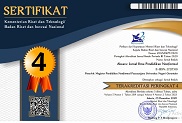Ikonisitas Perempuan Cantik pada Iklan Skincare MS Glow sebagai Budaya Populer : Kajian Semiotika
Abstract
Keywords
Full Text:
PDFReferences
Hermawan, Agus.2012. Komunikasi Pemasaran. Jakarta : Erlangga.
Teeuw, A. 2003. Sastra dan Ilmu Sastra. Bandung: Dunia Pustaka Jawa
Darmaprawira, Sulasmi. 2002. Warna: Teori dan Kreativitas Penggunanya. Bandung: ITB.
Eco, Umbeto. 1976. A theory semioties. Bloomington: Indiana University Press.
Barthes, Roland. 2007. Petualangan semiologi. Yogyakarta: Pustaka Pelajar.
Barthes, Roland. 2010. Imaji musik teks. Yogyakarta: Jalasutra.
Barthes, Roland. 2011. Mitologi. Bantul: Kreasi Wacana.
Sobur, Alex. 2009. Semiotika Komunikasi. Bandung: PT Remaja Rosdakarya.
Kaelan. 2009. Filasafat bahasa semiotika dan hermeneutika. Yogyakarta: Paradigma.
Hoed, Benny H. 2011. Semiotika dan dinamika sosial budaya. Depok: Komunitas Bambu.
Sukyadi, Didi. 2011. Teori dan Analisis Semiotika. Bandung: Rizqi Press.
Wibowo, Seto Wahyu. 2011. Semiotika komunikasi. Jakarta: Mitra Wacana Media.
Leeuwen , Theo van. 2005. Introducing social semiotics. New York: Routledge.
Berger, A.A. (2010). Pengantar semiotika: tanda-tanda dalam kebudayaan kontemporer. Yogyakarta: Tiara Wacana.
Sagita, Januar Adi. 2019. Nagita Slavina Lulusan Universitas di Australia, Intip Skill Bahasa Inggris-nya, Bagus Atau Nggak?. Terdapat di https://www.tribunnews.com (diunggah pada tanggal 9 Januari 2023).
Morovias, Yayang. 2018. Representasi Perempuan dalam iklan. Terdapat di https://www.hipwee.com/opini/representasi-perempuan-dalam-iklan/. (diunggah pada 24 Januari 2023).
Oumeish, Oumeish Youssef. 2001. The cultural and philosophical of cosmetisc in beauty and art through the medical history of mankind. Science Direct. Volume 19, Issue 4, July-Augustus 2001, Pages 375-386.
DOI: http://dx.doi.org/10.37905/aksara.9.2.1083-1092.2023
Refbacks
- There are currently no refbacks.
Copyright (c) 2023 Aksara: Jurnal Ilmu Pendidikan Nonformal

This work is licensed under a Creative Commons Attribution-ShareAlike 4.0 International License.
Publisher:
Magister Pendidikan Nonformal Pascasarjana Universitas Negeri Gorontalo
Jl. Soedirman No. 06 Gorontalo 96128 e-mail: jurnalaksara@ung.ac.id
http://ejurnal.pps.ung.ac.id







